Thomas Archer
| Thomas Archer | |
|---|---|
| Born | c.1668 |
| Died |
22 May 1743 his house Whitehall |
| Nationality | English |
| Occupation | Architect |
| Buildings |
St. Paul's, Deptford |
Thomas Archer (1668–1743) was an English Baroque architect, whose work is somewhat overshadowed by that of his contemporaries Sir John Vanbrugh and Nicholas Hawksmoor.
Life
Archer spent his youth at Umberslade Hall in Tanworth-in-Arden in Warwickshire, the youngest son of Thomas Archer, a country gentleman, Parliamentary Colonel and Member of Parliament, and Ann Leigh, daughter of the London haberdasher, Richard Leigh.[1] The exact date of Archer's birth is unknown, but can be inferred from the two documentary sources that mention his age. One is an entry in the Oxford University register recording his matriculation at Trinity College on 12 June 1686, aged 17; the other, his epitaph, survives in the parish church of Hale, Hampshire. If these records are accurate, he must have been born between 12 June 1668 and 22 May 1669. Thomas is the only one of the Archer children not to have his birth recorded in the Tamworth-in-Arden parish register, which suggests he may have been born elsewhere.[2] He attended Trinity College, Oxford, from which he matriculated on 12 June 1686.[3] After leaving university, he went on a Grand Tour, spending four years abroad and was influenced by the work of Bernini and Borromini.
At the commencement of the civil wars, he was a colonel in the parliamentary forces and raised a troop of horse at his own expense. But when he discovered the designs of the parliamentarians, he threw up his commission and emigrating, remained abroad until the restoration of the monarchy. Thereafter he represented the city of Warwick in the Cavalier Parliament.[4]
Churches
Archer's churches include St John's, Smith Square, Westminster, St Paul's, Deptford and St Philip, Birmingham, now Birmingham Cathedral. St John's and St Paul's were both built for the Commission for Building Fifty New Churches. John Summerson said these two buildings "represent the most advanced Baroque style ever attempted in England". According to the minutes of the Commissioners, Archer also "improved" Hawksmoor's designs for St Alfege's at Greenwich, although the nature of the improvements, or whether they were implemented, is unknown.[5]
At Hale, Hampshire, he remodelled St Mary's Church, which also contains his memorial, carved by Sir Henry Cheere to Archer's own design.[6]
Secular works
Archer's secular works included Roehampton House in Surrey, Welford Park in Berkshire, and the Cascade House and the west front and broadly bowed pilastered north front at Chatsworth House. In 1709–11 Archer designed a Baroque garden pavilion for Henry Grey, 1st Duke of Kent at Wrest Park, Silsoe, Bedfordshire. After 1712 Archer designed Hurstbourne Priors in Hampshire for John Wallop (later Earl of Portsmouth).
He was a founding governor of the Foundling Hospital in London in 1739, but was not involved in the construction of the resulting building, completed c. 1750. The architect for that project was Theodore Jacobsen.
Documented works
- Chatsworth House, North front, Derbyshire, c. 1705
- Heythrop Hall, Oxfordshire, c. 1705
- St Philip's, Birmingham, 1708–1715
- Garden pavilion, Wrest Park, Bedfordshire, 1709–1711
- Roehampton House, Surrey, 1712
- Cliveden House, Service pavilions and the quadrant colonnades, Buckinghamshire
- Hurstbourne Priors, Hampshire, 1712
- St John’s, Smith Square, London, 1713–1728
- St. Paul's, Deptford, 1712–1730
- Hale Park, Hampshire, 1715
- St Mary’s Church, additions, Hale, Hampshire, 1717
- Harcourt House, Cavendish Square, London, 1722
- Hale Park, the house Archer designed for himself.
Attributed works
- Welford Park, remodelling of house, Berkshire, 1700
- Chicheley Hall, Buckinghamshire, c. 1703
- Parish church, chancel, Chicheley, 1708
- Addiscombe House, Croydon, Surrey, c. 1703
- Monmouth House, Soho Square, London, 1703
- Russell House, King Street, Covent Garden, London, c. 1704
- Cascade House, Chatsworth House, Derbyshire, 1705
- Hill House, Cain Hill, Wrest Park, Bedfordshire, c. 1710, demolished
- Bramham Park, Yorkshire, c. 1710
- Kingston Maurward, Dorset, 1717–1720
- Marlow Place, Buckinghamshire, 1720
- Chettle House, Dorset, c. 1730
- Monument to Susannah Thomas, Hampton Church, Middlesex, c. 1731
- Archer Memorial, St Mary’s Church, Hale, Hampshire
- Thomas Archer (his father) monument, St Mary Magdalene Church, Tanworth-in-Arden, Warwickshire
Gallery
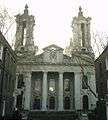 St. John's, Smith Square
St. John's, Smith Square St. John's, Smith Square
St. John's, Smith Square Thomas Archer's garden pavilion at Wrest Park, 2007
Thomas Archer's garden pavilion at Wrest Park, 2007 St. Philip's Cathedral, Birmingham
St. Philip's Cathedral, Birmingham St. Philip's Cathedral, Birmingham, west front
St. Philip's Cathedral, Birmingham, west front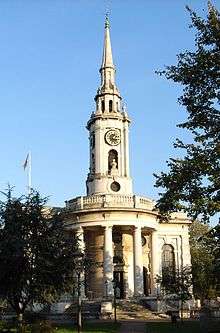 St Paul's Deptford
St Paul's Deptford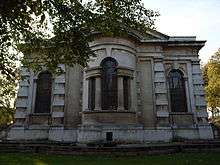 St Paul's Deptford, east side
St Paul's Deptford, east side St Paul's Deptford, north side
St Paul's Deptford, north side Cascade House Chatsworth
Cascade House Chatsworth Chatsworth North Front
Chatsworth North Front Heythrop Hall
Heythrop Hall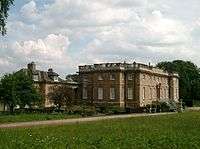 Bramham Park
Bramham Park Bramham Park
Bramham Park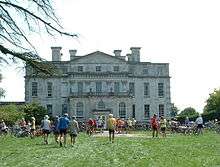 Kingston Maurward House
Kingston Maurward House Cliveden House
Cliveden House Roehampton House
Roehampton House
References
- ↑ The Little London Directory of 1677: the oldest printed list of the merchants and bankers of London. Edited by John Camden Hotton, 1863. A reprint of A Collection of the Names of Merchants living in and about the City of London, 11 October 1677, under licence from Roger L'Estrange. Richard Leigh and his wife Mary had six children, of which Ann was the eldest. The family lived in the parish of St. Helen's Bishopgate. Ann married Thomas Archer, the architect's father in 1649 in the parish of St. Peter-le-Poor.
- ↑ Joseph Foster, Alumni Oxonienses: The Members of the University of Oxford, 1500–1714 (Oxford: James Parker & Co., 189 1). Marcus Whiffen, Thomas Archer, vol. 3 (London: Art and Technics, 1950). Marcus Whiffen, Thomas Archer, architect of the English baroque, [New ed.] ed. (Los Angeles: Hennessey & Ingalls, 1973).
- ↑ page 10, Thomas Archer Architect of the English Baroque, Marcus Whiffen, 1973, Art and Technics
- ↑ A Genealogical History of the Dormant, Abeyant, Forfeited, and Extinct Peerages of the British Empire By Sir Bernard Burke, LL.D., Ulster King of Arms. Published by Harrison, 1866 - Baronetage - 636 pages; page 9.
- ↑ Downes, Kerry (1987) [first published 1970]. Hawksmoor. World of Art. London: Thames and Hudson. pp. 110–11. Downes suggests the use of the giant order of pilasters around the church may have been Archer's idea.
- ↑ "The Puzzle of St Mary's Church – Hale". Judith Leigh.
Further reading
- Andor Gomme, ‘Archer, Thomas (1668/9–1743)’, Oxford Dictionary of National Biography, (Oxford University Press, September 2004; online edn, January 2008) , accessed 8 November 2008.
- Whiffen, Marcus:Thomas Archer: Architect of the English Baroque,
- Hennessey & Ingalls, Santa Monica 1973, ISBN 0-912158-23-9
External links
| Wikimedia Commons has media related to Thomas Archer. |
| Court offices | ||
|---|---|---|
| Preceded by William Rowley |
Groom Porter 1705–1743 |
Succeeded by Charles FitzRoy |